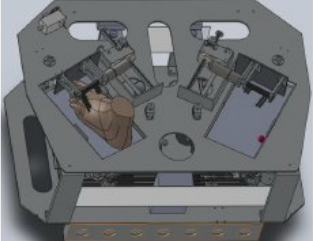
Schematic digital prototype for feet massage robot. (Image from the paper)
It is one of critical factors for a massage robot to find and position the acupuncture point precisely in order to cure the diseases. Based on large amount of sample data offline, Chinese medical empirical knowledge is also introduced to build the prediction model. The massagist prescription and the robot mechanism devise are both considered for robot positioning. Least squares method is of simplicity, easy to use and high efficiency. Its real-time calculation is very effective, too. A modeling method for robot positioning is proposed based on least squares. Knowledge consultation is set for the calculation of acupoint position. The robot needs to get the feature points of a foot to be massaged. The foot contour sampling data are divided into piecewise curve fitting. Q-learning is adopted to optimize the robot positioning for they are model free. CMAC (Cerebellar Model Articulation Controller) cerebellum model is incorporated into the function approximation of Q learning. The learning system is rewarded by referring to the strengths of instrumental signal. By the direct representation, the model of human pelma acupoint is expressed with the vector variables and formal computer language. Through prediction model's calculation, the robot will work out the rough position of acupuncture point. Meanwhile, Q learning does the online adjustment for accurate location. These strategies provide for the robot to automatically search and position the pelma acupoint with little real-time computation and storage. The idea of this paper also prompts a research cue for the development of Chinese medical standardization.
This work was published on INTERNATIONAL JOURNAL OF CONTROL AUTOMATION AND SYSTEMS,2016,14(2):628-636.titled Strategies for Feet Massage Robot to Position the Pelma Acupoints with Model Predictive and Real-time Optimization.